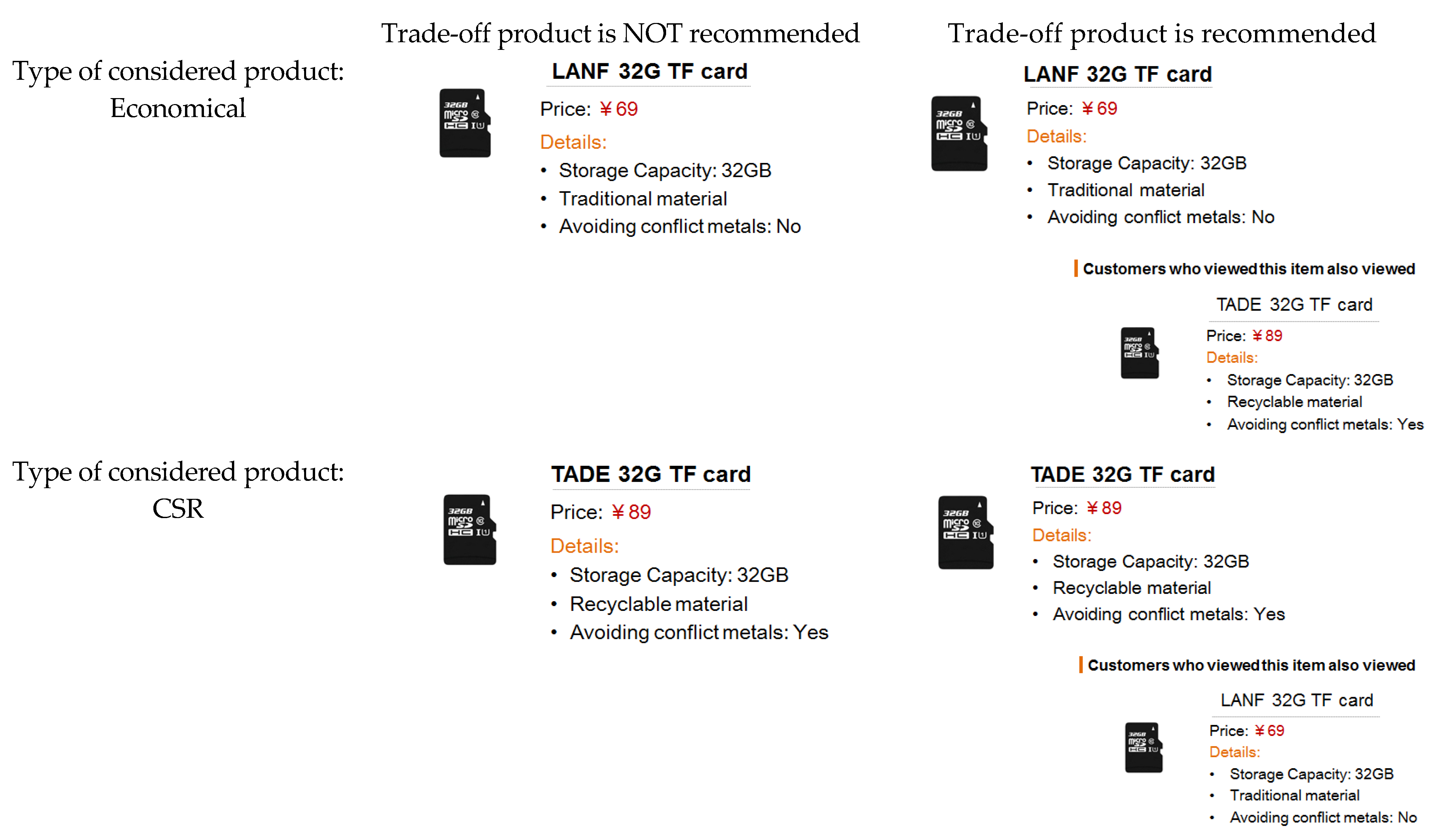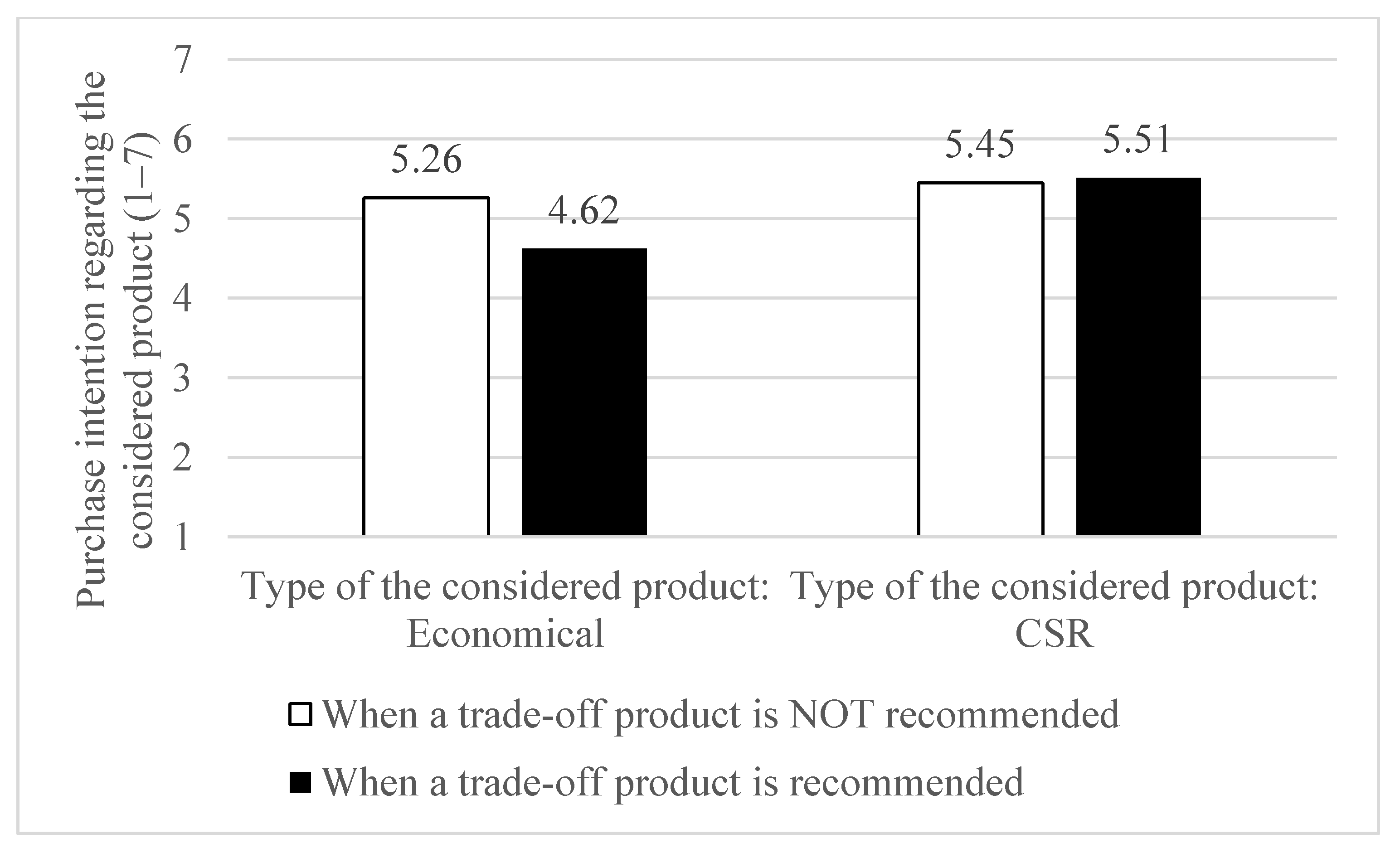Unintended CSR Violation Caused by Online Recommendation
Abstract
:1. Introduction
2. Theory and Hypotheses
2.1. Evaluability
2.2. CSR vs. Price
2.3. Evaluability between CSR and Price
3. Experiment 1
3.1. Method
3.1.1. Stimuli
3.1.2. Design
3.2. Results
Purchase Intentions Regarding the Considered Product
3.3. Discussion
4. Experiment 2
4.1. Method
4.1.1. Stimuli
4.1.2. Design
4.2. Results
Purchase Intentions Regarding the Considered Product
4.3. Discussion
5. General Discussion
6. Conclusions
Author Contributions
Funding
Institutional Review Board Statement
Informed Consent Statement
Data Availability Statement
Conflicts of Interest
References
- Forrester: U.S. Online Retail Sales to Hit $370 Billion by 2017. Available online: http://mashable.com/2013/03/12/forrester-u-s-ecommerce-forecast-2017/#Y_urYbd5Uskk (accessed on 29 March 2021).
- Nikolaeva, R.; Sriram, S. The Moderating Role of Consumer and Product Characteristics on the Value of Customized On-Line Recommendations. Int. J. Electron. Commer. 2006, 11, 101–123. [Google Scholar] [CrossRef]
- Kwak, M. Web Sites Learn to Make Smarter Suggestions. Sloan Manag. Rev. 2013, 42, 17. [Google Scholar]
- Lee, G.; Lee, W.J. Psychological reactance to online recommendation services. Inf. Manag. 2009, 46, 448–452. [Google Scholar] [CrossRef]
- Wang, H.-C.; Doong, H.-S. Online customers’ cognitive differences and their impact on the success of recommendation agents. Inf. Manag. 2010, 47, 109–114. [Google Scholar] [CrossRef]
- Tam, K.Y.; Ho, S.Y. Web Personalization as A Persuasion Strategy: An Elaboration Likelihood Mod-el Perspective. Inf. Syst. Res. 2005, 16, 271–291. [Google Scholar] [CrossRef] [Green Version]
- Senecal, S.; Nantel, J. The influence of online product recommendations on consumers’ online choices. J. Retail. 2004, 80, 159–169. [Google Scholar] [CrossRef]
- Ansari, A.; Essegaier, S.; Kohli, R. Internet Recommendation Systems. J. Mark. Res. 2000, 37, 363–375. [Google Scholar] [CrossRef]
- Häubl, G.; Murray, K.B. Murray Preference Construction and Persistence in Digital Marketplaces: The Role of Electronic Recommendation Agents. J. Consum. Psychol. 2003, 13, 75–91. [Google Scholar] [CrossRef]
- Xiao, B.; Benbasat, I. E-Commerce Product Recommendation Agents: Use, Characteristics, and Impact. MIS Q. 2007, 31, 137. [Google Scholar] [CrossRef] [Green Version]
- Häubl, G.; Trifts, V. Consumer Decision Making in Online Shopping Environments: The Effects of Interactive Decision Aids. Mark. Sci. 2000, 19, 4–21. [Google Scholar] [CrossRef] [Green Version]
- Lepkowska-White, E. Are they listening? Designing online recommendations for today’s consumers. J. Res. Interact. Mark. 2013, 7, 182–200. [Google Scholar] [CrossRef]
- Zanker, M.; Rook, L.; Jannach, D. Measuring the impact of online personalisation: Past, present and future. Int. J. Human Comput. Stud. 2019, 131, 160–168. [Google Scholar] [CrossRef]
- Sulikowski, P.; Zdziebko, T.; Turzyński, D.; Kańtoch, E. Human-website interaction monitoring in recommender systems. Procedia Comput. Sci. 2018, 126, 1587–1596. [Google Scholar] [CrossRef]
- Sulikowski, P.; Zdziebko, T. Deep Learning-Enhanced Framework for Performance Evaluation of a Recommending Interface with Varied Recommendation Position and Intensity Based on Eye-Tracking Equipment Data Processing. Electronics 2020, 9, 266. [Google Scholar] [CrossRef] [Green Version]
- Jannach, D.; Adomavicius, G. Recommendations with a Purpose. In Proceedings of the 10th ACM Conference on Recommender Systems, Boston, MA, USA, 15–19 September 2016; pp. 7–10. [Google Scholar]
- Chen, H.; Chiang, R.H.L.; Storey, V.C. Business Intelligence and Analytics: From Big Data to Big Impact. MIS Q. 2012, 36, 1165. [Google Scholar] [CrossRef]
- Bortko, K.; Bartków, P.; Jankowski, J.; Kuras, D.; Sulikowski, P. Multi-criteria evaluation of recommending inter-faces towards habituation reduction and limited negative impact on user experience. Procedia Comput. Sci. 2019, 159, 2240–2248. [Google Scholar] [CrossRef]
- Sulikowski, P.; Zdziebko, T.; Turzyński, D. Modeling online user product interest for recommender systems and ergonomics studies. Concurr. Comput. Pract. Exp. 2019, 31, 4301. [Google Scholar] [CrossRef]
- Zhang, Q.; Lu, J.; Jin, Y. Artificial intelligence in recommender systems. Complex Intell. Syst. 2021, 7, 439–457. [Google Scholar] [CrossRef]
- Amazon’s Recommendation Secret. Available online: https://fortune.com/2012/07/30/amazons-recommendation-secret/ (accessed on 29 March 2021).
- Wang, J.; Huang, P.; Zhao, H.; Zhang, Z.-B.; Zhao, B.; Lee, D.L. Billion-scale Commodity Embedding for E-commerce Recommendation in Alibaba. In Proceedings of the 24th ACM SIGKDD International Conference on Knowledge Discovery Data Mining, London, UK, 19–23 August 2018; pp. 839–848. [Google Scholar]
- Gong, Y.; Jiang, Z.; Feng, Y.; Hu, B.; Zhao, K.; Liu, Q.; Ou, W. EdgeRec: Recommender System on Edge in Mobile Taobao. Assoc. Comput. Mach. 2020, 20, 19–23. [Google Scholar]
- How Does the Recommendation System Work on Tmall? Available online: https://www.alibabacloud.com/blog/how-does-the-recommendation-system-work-on-tmall_595335/ (accessed on 29 March 2021).
- Wang, Y.; Chan, S.C.; Ngai, G. Applicability of Demographic Recommender System to Tourist Attractions: A Case Study on TripAdvisor. In Proceedings of the IEEE/WIC/ACM International Conferences on Web Intelligence and Intelligent Agent Tech-nology, Macau, China, 4–7 December 2012; pp. 97–101. [Google Scholar]
- Parra, D.; Sahebi, S. Recommender Systems: Sources of Knowledge and Evaluation Metrics. In Advanced Techniques in Web Intelligence-2, Studies in Computational Intelligence; Velásquez, J., Palade, V., Jain, L., Eds.; Springer: Berlin/Heidelberg, Germany, 2013; p. 452. [Google Scholar]
- Chandrak, M.; Girase, S.; Mukhopadhyay, D. Introducing Hybrid Technique for Optimization of Book Recom-mender System. Procedia Comput. Sci. 2015, 45, 23–31. [Google Scholar] [CrossRef] [Green Version]
- Sulikowski, P.; Zdziebko, T. Horizontal vs. Vertical Recommendation Zones Evaluation Using Behavior Tracking. Appl. Sci. 2020, 11, 56. [Google Scholar] [CrossRef]
- Hsee, C.K.; Loewenstein, G.F.; Blount, S.; Bazerman, M.H. Preference reversals between joint and separate evaluations of options: A review and theoretical analysis. Psychol. Bull. 1999, 125, 576–590. [Google Scholar] [CrossRef]
- Hsee, C.K.; Zhang, J. General Evaluability Theory. Perspect. Psychol. Sci. 2010, 5, 343–355. [Google Scholar] [CrossRef] [PubMed]
- Creyer, E.H.; Ross, W.T. The impact of corporate behavior on perceived product value. Mark. Lett. 1996, 7, 173–185. [Google Scholar] [CrossRef]
- Lois, A.; Deborah, J. Webb The Effects of Corporate Social Responsibility and Price on Consumer Re-sponses. J. Consum. Aff. 2005, 39, 121–147. [Google Scholar]
- De Pelsmacker, P.; Driesen, L.; Rayp, G. Do Consumers Care about Ethics? Willingness to Pay for Fair-Trade Coffee. J. Consum. Aff. 2005, 39, 363–385. [Google Scholar] [CrossRef]
- Yoon, Y.; Chastagner, K.; Joo, J. Inner-Self vs. Outer-Self and Socially Responsible Product Consumption. Sustainability 2020, 12, 9362. [Google Scholar] [CrossRef]
- Hsee, C.K. The Evaluability Hypothesis: An Explanation for Preference Reversals between Joint and Sepa-rate Evaluations of Alternatives. Organ. Behav. Hum. Decis. Process. 1996, 67, 247–257. [Google Scholar] [CrossRef]
- Yeung, C.W.M.; Soman, D. Attribute Evaluability and the Range Effect. J. Consum. Res. 2005, 32, 363–369. [Google Scholar] [CrossRef]
- Willemsen, M.C.; Keren, G. The role of negative features in joint and separate evaluation. J. Behav. Decis. Mak. 2004, 17, 313–329. [Google Scholar] [CrossRef]
- Chu, P.Y.; Chang, C.C.; Chen, C.Y.; Wang, T.Y. Countering Negative Country-of-Origin Ef-fects: The Role of Evaluation Mode. Eur. J. Mark. 2010, 44, 1055–1076. [Google Scholar] [CrossRef] [Green Version]
- Okada, E.M. Justification Effects on Consumer Choice of Hedonic and Utilitarian Goods. J. Mark. Res. 2005, 42, 43–53. [Google Scholar] [CrossRef]
- Roy, R.; Ng, S. Regulatory focus and preference reversal between hedonic and utilitarian consump-tion. J. Consum. Behav. 2012, 11, 81–88. [Google Scholar] [CrossRef]
- Chen, X.; Kim, S.; Joo, J. How Do We Nudge People to Choose Aesthetically Pleasing Products? Arch. Des. Res. 2019, 32, 61–73. [Google Scholar] [CrossRef]
- Tom, J.; Peter, A. Dacin The Company and the Product: Corporate Associations and Consumer Product Responses. J. Mark. 1997, 61, 68–84. [Google Scholar]
- Lafferty, B.A.; Goldsmith, R.E. Corporate Credibility’s Role in Consumers’ Attitudes and Purchase Intentions When a High versus a Low Credibility Endorser Is Used in the Ad. J. Bus. Res. 1999, 44, 109–116. [Google Scholar] [CrossRef]
- Murray, K.B.; Vogel, C.M. Using a hierarchy-of-effects approach to gauge the effectiveness of corporate social responsibility to generate goodwill toward the firm: Financial versus nonfinancial impacts. J. Bus. Res. 1997, 38, 141–159. [Google Scholar] [CrossRef]
- Sen, S.; Bhattacharya, C.B. Bhattacharya Does Doing Good Always Lead to Doing Better? Consumer Reactions to Cor-porate Social Responsibility. J. Mark. Res. 2001, 38, 225–244. [Google Scholar] [CrossRef]
- Öberseder, M.; Schlegelmilch, B.B.; Gruber, V. Why Don’t Consumers Care About CSR? A Qualitative Study Exploring the Role of CSR in Consumption Decisions. J. Bus. Ethics 2011, 104, 449–460. [Google Scholar] [CrossRef] [Green Version]
- Pomering, A.; Dolnicar, S. Assessing the Prerequisite of Successful CSR Implementation: Are Consumers Aware of CSR Initiatives? J. Bus. Ethic 2008, 85, 285–301. [Google Scholar] [CrossRef]
- Folkes, V.S.; Kamins, M.A. Folkes, V.S.; Kamins, M.A. Effects of Information about Firms’ Ethical and Unethical Actions on Consumers’ Attitudes. J. Consum. Psychol. 1999, 8, 243–259. [Google Scholar] [CrossRef]
- Handelman, J.M.; Arnold, S.J. The Role of Marketing Actions with A Social Dimension: Appeals to the Institutional Environment. J. Mark. 1999, 63, 33–48. [Google Scholar] [CrossRef]
- Bhattacharya, C.; Sen, S. Doing Better at Doing Good: When, Why, and How Consumers Respond to Corporate Social Initiatives. Calif. Manag. Rev. 2004, 47, 9–24. [Google Scholar] [CrossRef]
- Ying, Y.; Feinberg, F.; Wedel, M. Leveraging Missing Ratings to Improve Online Recommenda-tion Systems. J. Mark. Res. 2006, 43, 355–365. [Google Scholar] [CrossRef] [Green Version]
- Jeuland, A.P.; Shugan, S.M. Managing Channel Profits. Mark. Sci. 1983, 2, 239–272. [Google Scholar] [CrossRef]
- Lal, R.; Matutes, C. Retail Pricing and Advertising Strategies. J. Bus. 1994, 67, 345. [Google Scholar] [CrossRef]
- Lariviere, M.A.; Padmanabhan, V. Slotting Allowances and New Product Introductions. Mark. Sci. 1997, 16, 112–128. [Google Scholar] [CrossRef]
- Moorthy, S. A General Theory of Pass-Through in Channels with Category Management and Retail Compe-tition. Mark. Sci. 2005, 24, 110–122. [Google Scholar] [CrossRef]
- Singer, Jason Starbucks Japan Plans Changes as It Struggles for Profitability. Wall Street Journal, 19 February 2003. Available online: https://www.wsj.com/articles/SB1045649802211646343 (accessed on 29 March 2021).
- Agrawal, D.; Lal, R. Contractual Arrangements in Franchising: An Empirical Investigation. J. Mark. Res. 1995, 32, 213–221. [Google Scholar] [CrossRef]
- Iyer, G. Coordinating Channels Under Price and Nonprice Competition. Mark. Sci. 1998, 17, 338–355. [Google Scholar] [CrossRef] [Green Version]
- Arya, A.; Mittendorf, B.; Sappington, D.E.M. The Bright Side of Supplier Encroachment. Mark. Sci. 2007, 26, 651–659. [Google Scholar] [CrossRef]
- Tedeschi, B. New level of competition: When a supplier gets into its customers’ business. New York Times, 26 September 2005. [Google Scholar]
- Roy, D.; Graeff, T.R. Consumer Attitudes Toward Cause-Related Marketing Activities in Professional sports. Sport Mark. Q. 2003, 12, 163–172. [Google Scholar]
- Peloza, J.; White, K.; Shang, J. Good and Guilt-Free: The Role of Self-Accountability in Influencing Preferences for Products with Ethical Attributes. J. Mark. 2013, 77, 104–119. [Google Scholar] [CrossRef] [Green Version]




| Hypothesis | Finding | Reference |
|---|---|---|
| Hypothesis 1. The recommendation of a CSR product decreases consumers’ purchase intentions regarding an economical product. | Supported: Participants’ purchase intentions regarding the economical product decreased when the CSR product was recommended | Brown and Dacin [42], Sen and Bhattacharya [45], Bhattacharya and Sen [50] |
| Hypothesis 2. The recommendation of an economical product does not decrease consumers’ purchase intentions regarding a CSR product. | Supported: Participants’ purchase intentions regarding the CSR product did not change when the economical product was recommended. | Creyer and Ross [31] |
| Hypothesis 3. When the reinforcement information about CSR is provided, the recommendation of a CSR product does not decrease consumers’ purchase intentions regarding an economical product. | Supported: When participants were informed about CSR, their purchase intentions regarding the economical product did not change when the CSR product was recommended. When participants were informed about CSR, their purchase intentions regarding the CSR product did not change when the economical product was recommended. | Pomering and Dolnicar [47] |
Publisher’s Note: MDPI stays neutral with regard to jurisdictional claims in published maps and institutional affiliations. |
© 2021 by the authors. Licensee MDPI, Basel, Switzerland. This article is an open access article distributed under the terms and conditions of the Creative Commons Attribution (CC BY) license (https://creativecommons.org/licenses/by/4.0/).
Share and Cite
Yoon, Y.; Fu, Y.; Joo, J. Unintended CSR Violation Caused by Online Recommendation. Sustainability 2021, 13, 4053. https://doi.org/10.3390/su13074053
Yoon Y, Fu Y, Joo J. Unintended CSR Violation Caused by Online Recommendation. Sustainability. 2021; 13(7):4053. https://doi.org/10.3390/su13074053
Chicago/Turabian StyleYoon, Yeujun, Yating Fu, and Jaewoo Joo. 2021. "Unintended CSR Violation Caused by Online Recommendation" Sustainability 13, no. 7: 4053. https://doi.org/10.3390/su13074053
APA StyleYoon, Y., Fu, Y., & Joo, J. (2021). Unintended CSR Violation Caused by Online Recommendation. Sustainability, 13(7), 4053. https://doi.org/10.3390/su13074053







